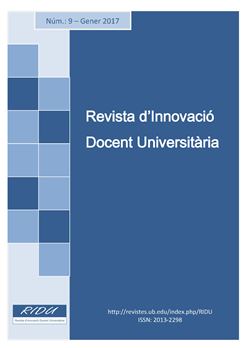El aula invertida y el aprendizaje en equipo: dos metodologías para estimular al alumnado repetidor
DOI:
https://doi.org/10.1344/RIDU2017.9.1Palabras clave:
Innovación docente, Aula invertida, Aprendizaje en equipoResumen
Este artículo propone el uso del aula invertida y el aprendizaje en equipo para mejorar las actitudes de aprendizaje del estudiante en los Grupos de Intensificación de Estudio (GIE). Los GIE están diseñados para aquel estudiante que repite una asignatura en alguno de los grados impartidos en la Facultad de Economía y Empresa de la Universitat de Barcelona. Hemos implementado ambas metodologías en tres GIE impartidos por la sección de Teoría Económica del Departamento de Economía de la Universitat de Barcelona. Los resultados obtenidos en los años académicos 2013-2014 y 2014-15 revelan mejoras significativas en el rendimiento de los estudiantes que siguieron estas metodologías.Citas
Baepler, P. (2014) It's not about seat time: Blending, flipping, and efficiency in active learning classrooms. Computers and Education, 78, pp. 227-236.
Bergmann, J., Sams, A. (2012) Flip your classroom: Reach every student in every class every day. Washington, D.C.: International Society for Technology in Education.
Berrett, D. (2012) How ‘flipping’ the classroom can improve the traditional lecture. The Chronicle of Higher Education. Disponible en: http://chronicle.com/article/How-Flipping-the-Classroom/130857/.
Chung, K. (2014) Professors ‘flip’ classrooms, enhance learning. Daily Tar Heel. Disponible en: http://www.dailytarheel.com/article/2014/01/flipped-classrooms-0108.
Crouch, C., Mazur, E. (2001) Peer Instruction: Ten Years of Experience and Results. American Journal of Physics, 69, pp. 970-977.
Deslauriers, L., Schelew, E., Wieman, C. (2011) Improved Learning in a Large-Enrollment Physics Class. Science, 332, pp. 862-864.
Hong, T., Pham, T. (2013) Using group projects as a strategy to increase cooperation among low - and high-achieving students. Higher Education Research and Development, 32, pp. 993-1006.
Jackson, M.W., Prosser, M.T. (1989) Less lecturing, more learning. Studies in Higher Education, 14, pp. 55-68.
King, A. (1993). From sage on the stage to guide on the side. College teaching, 41, pp. 30-35.
Knight, J.K., Wood, W.B. (2005) Teaching More by Lecturing Less. Cell Biology Education, 4, pp. 298-310.
Kruger, J., Dunning, D. (1999) Unskilled and unaware of it: How difficulties in recognizing one’s own incompetence lead to inflated self-assessments. Journal of Personality and Social Psychology, 77, pp. 1121-1134.
Lage, M.J., Platt, G.T., Treglia, M. (2000) Inverting the classroom: A gateway to creating an inclusive learning environment. The Journal of Economic Education, 31, pp. 30-43.
Mazur, E. (1997) Peer Instruction: A User's Manual Series in Educational Innovation. Prentice Hall, Upper Saddle River, NJ.
McLaughlin, J.C. (2013) Pharmacy student engagement, performance, and perception in a flipped satellite classroom. American Journal of Pharmaceutical Education, 77, pp. 1-8.
Michaelsen, L.K., Knight, A.B., Fink, L.D. (2004) Team-Based Learning: A Transformative Use of Small Groups in College Teaching. Sterling, Va. Stylus.
Millis, B. J., Cottell, P.G. (1998) Cooperative Learning for Higher Education Faculty. Oryx Press, Phoenix, Ariz.
Missildine, K., Fountain, R., Summers, L., Gosselin, K. (2013) Flipping the classroom to improve student performance and satisfaction. Journal of Nursing Education, 52, pp. 597- 599.
Nordberg, D. (2008) Group projects: More learning? Less fair? A conundrum in assessing postgraduate business education. Assessment and Evaluation in Higher Education, 33, pp. 481-492.
Opdecam, E., Everaert, P., Van Keer, H. (2014) Preferences for Team Learning and Lecture-Based Learning Among First-Year Undergraduate Accounting Students. Research in Higher Education, 55, pp. 400-432.
Park, E.L., Choi, B.K. (2014) Transformation of classroom spaces: traditional versus active learning classroom in colleges. Higher Education, 68, pp. 749-771.
Pennebaker, J.W., Gosling, S.D., Ferrell, J.D. (2013) Daily Online Testing in Large Classes: Boosting College Performance while Reducing Achievement Gaps. PloS ONE, 8(11), e79774.
Prieto, A., Díaz, D., Montserrat, J., Reyes, E. (2014) Experiencias de aplicación de estrategias de gamificación a entornos de aprendizaje universitario. ReVisión, 7, pp. 76-92.
Roediger, H.L. III, Putnam, A.L., Smith, M.A. (2011) Ten benefits of testing and their applications to educational practice. Edited by: Mestre, J.P., Ross, B.H. Psychology of Learning and Motivation: Cognition in Education,Book Series: Psychology of Learning and Motivation, Volumen 55, pp. 1-36.
Shah, S.Z.A. (2013) The use of group activities in developing personal transferable skills. Innovations in Education and Teaching International, 50, pp. 297-307.
Strayer, J. (2012) How learning in an inverted classroom influences cooperation, innovation and task orientation. Learning Environments, 15, pp. 171-193.
Wilson, S.G. (2013) The flipped classroom: A method to address the challenges of an undergraduate statistics course. Teaching of Psychology, 40, pp. 193-199.
Yamarik, S. (2007) Does Cooperative Learning Improve Student Learning Outcomes? Journal of Economic Education, 38, pp. 259-277.
Descargas
Publicado
Número
Sección
Licencia
Los autores que publiquen en la revista RIDU, aceptan las condiciones siguientes:
- El autor/a conserva los derechos de autoría y otorga a la revista el derecho a la primera publicación de la obra.
- Los textos se publicarán bajo la licencia Reconocimiento 4.0 España de Creative Commons, la cual permite compartir, distribuir, reproducir y la comunicación pública, siempre que se reconozca la autoría i la revista.







